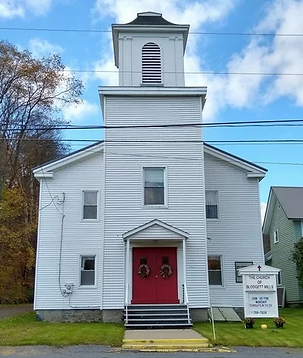History of
The Church of Blodgett Mills
The Church of Blodgett Mills building has had a long and somewhat complicated past. Not only has it had multiple names, but at one point the whole building itself was moved—something almost unheard of at the time. Although it wasn't the very first church building in Cortland County, its story is most certainly unique, possibly in the entire state.
The very first church organized in Cortland County, New York, was Homer Baptist Church on October 3, 1801. At the time, the county’s population was sparse, and its sixteen charter members were widely scattered. On Sabbath days, they traveled long distances to attend services in various homes, but the church nevertheless grew. By 1807, it had a regular pastor; and on January 8, 1810, the church was incorporated at Albany as the “First Baptist Society of the Town of Homer.” At the same meeting, it was proposed to build “a meeting house.”
This first meeting house was built the following year and dedicated in June 1812. A wooden structure, it was about 50 feet long by 35 feet wide, and its sanctuary had box pews with “push button doors,” which members owned or rented. There was “a gallery [balcony] on three sides,” the middle being the choir loft, which was above a “high pulpit.” In all, it cost $2175 to build.

Example of box pews and an elevated pulpit
The church building sat on farmland that was owned by John Stillman (1777-1862), which eventually became part of the city of Cortland. By all accounts, its exact location was the northwest corner of the junction of Fitz Avenue, North Main Street, and Adams Avenue (now the intersection of West Main Street, North Main Street, and Homer Avenue, respectively. Since 1911, Cortland city’s hospital has occupied this corner, and it is now the site of Guthrie Cortland Medical Center).

The original Baptist meeting house (icon northwest of the town of Cortland)
was one of the few churches included in an 1840 Cortland County map
As the years went by, the Baptist church flourished; in fact, it gave rise to four churches. In 1805, the church voted letters of dismissal to its Virgil brethren to form the Virgil Baptist Church; similarly, in 1827, letters were granted to members to form the First Baptist Church of McGraw and the First Baptist Church of Homer (village). As for the original congregation, by 1831, it had over 200 members and had outgrown its building. Its members voted that year to construct a new meeting house on Church Street in downtown Cortland next to the Presbyterian Church. This second church building was dedicated on October 3, 1833, leaving the first building vacant and unused for several years, except for a year’s rental to another church.
Meanwhile, down the Tioughnioga River, a small group of Reformed Methodists in the hamlet of Blodgett Mills were meeting in a schoolhouse. They asked to buy the original Baptist church building, and on October 1, 1838, the First Baptist Church of Cortland voted to sell it to them. Trustees of the Methodists then purchased a plot of land in Blodgett Mills from Leonard Tisdale (1776-1850) for $50, and they hired builder Polydore B. Corwin (1801-1893) to move the church building there. This move took place about 1840.
To accomplish this herculean feat, Polydore B. Corwin and his brother Ezra took apart the church building piece by piece and numbered them all. They then used twelve oxen to haul everything from Cortland to the hillside lot in Blodgett Mills, five miles away, where they reconstructed the building. One section was cut off, and a tower was later erected; otherwise, the building with its massive pine timbers was exactly as it had been in 1811. It was now the Reformed Methodist Church of Blodgett Mills.

The Reformed Methodist Church appeared in Smith’s 1855 Map of Cortland County (“M. Ch,” above), and the Wesleyan Methodist Church in Everts’ 1876 map
(church icon, below)

In 1857, the Reformed Methodists voted to become Wesleyan Methodists, and the Wesleyan Methodist Church of Blodgett Mills continued for about thirty years. After a Methodist Episcopal church moved in across the street though, the Wesleyan Methodists’ numbers dwindled, to the point that their services ceased.
And so it was on June 4, 1890, that the Wesleyan Methodist Church sold the building back to the Baptists, and the church became the First Baptist Church of Blodgett Mills. The building was Baptist again for its centennial celebration in 1911. It also hosted a special shared service in 1926 to commemorate the 125th anniversary of the beginning of the First Baptist Church of Cortland.
Since its move to Blodgett Mills, the church building has been much altered: The old box pews and the high pulpit, of course, are gone, replaced by conventional pews and a platform with a podium. Surprisingly, the podium is now at what was the back of the sanctuary, meaning the pews face the opposite direction. The sanctuary was enlarged and remodeled with a lower ceiling that covers the two side balconies; the choir loft was also partitioned off for a prayer room. Last, a large addition was built onto the back of the building for a fellowship hall and Sunday School.
The church’s name has also changed twice since it became Baptist again. In 1932, the church became the Independent Baptist Church of Blodgett Mills, and in 1997, simply the Church of Blodgett Mills. It is now affiliated with Village Missions.
Although it may look different outwardly, underneath the building is still the same structure built back in 1811. It was the first building of the first church organized in Cortland County, and at 210 years old, it is the oldest church edifice in the county as well as the oldest still being used for its original purpose—to proclaim salvation through the Lord Jesus Christ.

